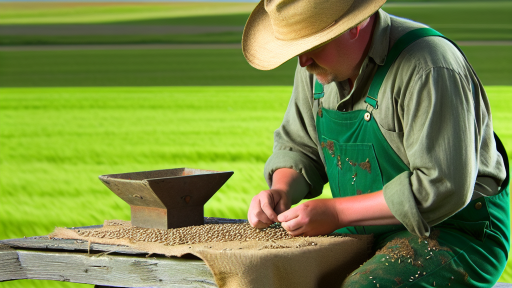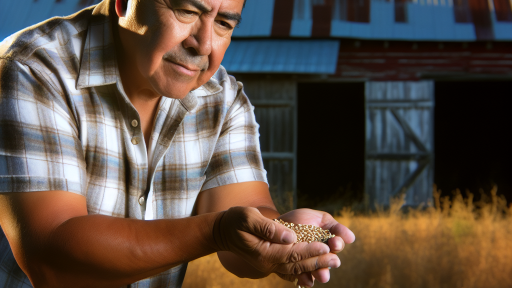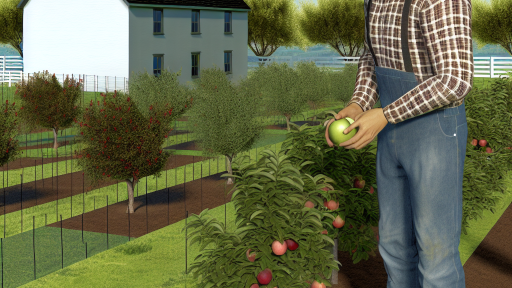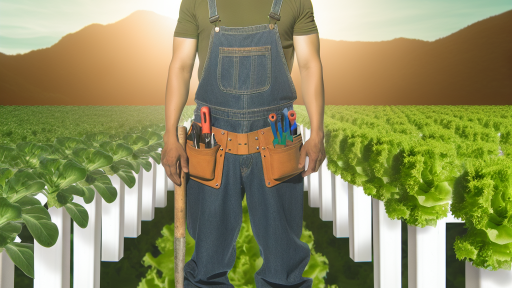Understanding the Seasonal Needs of Container Plants
Spring Care for Container Gardens
Spring signals awakening for container plants.
Start by assessing the condition of the soil.
Fresh potting soil promotes healthy root growth.
Replenishing nutrients is essential in this season.
Consider adding slow-release fertilizer to the mix.
Next, inspect the drainage holes of each container.
Clear any debris to prevent waterlogging.
This is the perfect time to repot any overcrowded plants.
Keep a close eye on weather conditions as frost can still occur.
Protect sensitive plants with burlap if needed.
Summer Requirements for Container Plants
Summer heat can stress container plants significantly.
Ensure consistent watering, especially during hot spells.
Check soil moisture daily and water as necessary.
Mulching helps retain moisture and regulate soil temperature.
Apply a layer of organic mulch to topsoil.
Transform Your Agribusiness
Unlock your farm's potential with expert advice tailored to your needs. Get actionable steps that drive real results.
Get StartedAdditionally, consider shading sensitive plants during peak heat.
Pruning dead or yellow leaves can also encourage new growth.
Check for pests which can thrive in warm weather conditions.
Treat infestations promptly with insecticidal soap if needed.
Autumn Preparation and Maintenance
As temperatures start to cool, assess plant health again.
Begin to reduce watering as plant growth slows.
Remove any dead foliage to prevent diseases.
Consider transitioning to winter crops if applicable.
Invest in frost fabric to protect plants from early chills.
Harvest edible crops before the first frost for best flavor.
Clean all containers thoroughly before winter storage.
This helps to eliminate pests and disease agents.
Winter Care for Container Plants
Winter can be harsh on container plants.
Move containers to sheltered locations if possible.
Group pots together to create a microclimate.
Ensure to monitor for moisture in the soil during dry spells.
Consider wrapping containers in burlap to insulate roots.
Some tropical plants may require indoor relocation.
Provide adequate light to ensure their survival indoors.
Water less frequently during dormancy, but don’t let them dry out completely.
Plan for spring by starting seeds indoors with care.
Preparing Your Containers for Winter: Tips and Techniques
Evaluating Container Options
Start by assessing the materials of your containers.
Some materials withstand cold better than others.
For example, ceramic and clay can crack in frost.
Showcase Your Farming Business
Publish your professional farming services profile on our blog for a one-time fee of $200 and reach a dedicated audience of farmers and agribusiness owners.
Publish Your ProfileConsider switching to plastic or fiberglass containers.
These options provide better insulation during winter.
Removing Plants and Soil
Next, carefully remove all plants from your containers.
Check the roots for any signs of disease or pests.
Dispose of any unwanted plant material in a compost pile.
Following this, empty out the existing soil.
Properly store or discard the soil according to your plan.
Cleaning Containers
Now, it’s time to clean your empty containers.
Use a mixture of water and vinegar to disinfect them.
This step helps remove any lingering disease pathogens.
Rinse thoroughly to ensure all cleaning residue is gone.
Insulating Containers
After cleaning, this is the time to insulate your containers.
You can use bubble wrap or landscape fabric for insulation.
Wrap the outside of each container to protect roots.
Alternatively, place them in a sheltered area, like a garage.
Winterizing Perennials
If you have perennials, consider winterizing them.
Cut back any dead foliage, but leave healthy stems.
Mulching around the base can protect the roots.
This layer also helps retain moisture during dry spells.
Checking for Pests
Before winter fully sets in, check for pests once more.
Examine the containers and their surroundings for any signs.
If you find any unwanted guests, take appropriate action.
Consider using organic pesticides as a last resort.
Planning for Spring
Winter is also a great time to plan for spring gardening.
Research which plants you want to grow next season.
Make a list of supplies you will need for your container garden.
This proactive approach allows you to be ready when spring arrives.
Spring Awakening: Cleaning and Refreshing Containers
Assessing Container Condition
Begin your spring container maintenance by assessing the condition of each container.
Check for cracks or damage that may have occurred during winter.
Next, determine if the soil needs replacement or refreshing.
Clearly, old soil may lose nutrients, so consider replenishing it.
Cleaning Your Containers
Start the cleaning process by emptying the containers completely.
Remove any old soil and debris to prepare for a fresh start.
Use a soft brush and a mixture of water and mild soap for effective cleaning.
Clearly rinse the containers thoroughly to avoid soap residue.
For stubborn stains or algae, consider a diluted bleach solution.
After cleaning, allow your containers to dry completely in the sun.
Refreshing Soil and Drainage
Select high-quality potting mix to ensure healthy container plants.
Mix in slow-release fertilizer to provide necessary nutrients.
Ensure that the containers have adequate drainage holes.
Showcase Your Farming Business
Publish your professional farming services profile on our blog for a one-time fee of $200 and reach a dedicated audience of farmers and agribusiness owners.
Publish Your ProfileIf the holes are blocked, use a skewer or similar tool to clear them out.
Choosing New Plants
Consider seasonal plants that thrive in the warmer spring weather.
Choose varieties that match your local climate and space available.
Mix different species to create a vibrant and diverse container design.
Arranging and Planting
Start by placing taller plants in the center or back for depth.
Fill in with medium and trailing plants for a balanced look.
Plant according to spacing recommendations for each type.
Water the newly planted containers thoroughly to help them settle.
You Might Also Like: Strategies For Effective Seed Rotation
Summer Care: Watering and Fertilizing Guidelines for Hot Months
Understanding Watering Needs
Container gardens require regular watering during the summer months.
The heat can quickly dry out your plants, causing stress.
To prevent this, check the moisture level daily.
Water deeply to encourage healthy root development.
Remember, it’s better to water thoroughly and less frequently.
During particularly hot days, you may need to water twice.
Choosing the Right Time to Water
Watering early in the morning is highly recommended.
This allows time for the water to soak in before the sun peaks.
Watering in the evening can lead to disease due to overnight moisture.
Adapt your schedule based on temperature and humidity levels.
Effective Fertilizing Practices
Simultaneously, your plants need nutrients to thrive in the summer.
Use a balanced, water-soluble fertilizer every two weeks.
Pay attention to the specific needs of each plant type.
Over-fertilizing can harm your plants, so follow instructions carefully.
Recognizing Signs of Stress
Be on the lookout for signs of stress in your container plants.
Wilting leaves or yellowing foliage may indicate underwatering.
Conversely, browning leaf edges can signal overwatering.
Adjust your watering and fertilizing routine as needed.
Maintaining Soil Quality
Healthy soil promotes strong plant growth throughout the summer.
Regularly check for compacted soil in your containers.
If necessary, gently aerate the soil to improve drainage.
Consider adding organic matter to enhance soil quality.
Adjusting for Specific Plant Needs
Different plants have varying watering and fertilizing needs.
Research the specific requirements of each plant in your garden.
Some may thrive on less water, while others need more frequent care.
Group plants with similar needs to simplify your maintenance routine.
See Related Content: Cost-Effective Aquaponics Setup Tips
Fall Harvest: Best Practices for Harvesting and Preparing for Cold Weather
Timing Your Harvest
Harvest your crops when they reach peak ripeness.
Monitor the weather closely as fall progresses.
Late afternoon is ideal for harvesting to minimize moisture.
Harvesting Techniques
Use sharp tools to avoid damaging plants.
Showcase Your Farming Business
Publish your professional farming services profile on our blog for a one-time fee of $200 and reach a dedicated audience of farmers and agribusiness owners.
Publish Your ProfileCut stems cleanly to promote future growth.
Handle fruits and vegetables gently to prevent bruising.
Proper Storage of Produce
Wash produce before storing to remove dirt and pests.
Store in a cool, dark place to increase shelf life.
Utilize breathable containers like paper bags or baskets.
Preparing for Cold Weather
Review your container gardening setup before cold hits.
Insulate pots with materials such as burlap or straw.
Consider grouping containers together for added warmth.
Choosing Cold-Hardy Plants
Select plants that can withstand frost and colder temperatures.
Examples include kale, cabbage, and certain root vegetables.
These plants can thrive even as temperatures drop.
Utilizing Protective Covers
Cover plants with row covers or blankets during frost warnings.
These covers trap heat effectively around the plants.
Check them regularly to ensure proper ventilation.
Maintaining Soil Health
Test soil health before the winter season.
Add organic matter to enhance soil structure.
Consider mulching to protect soil and retain moisture.
Planning for Next Season
Reflect on what worked and what didn’t this season.
Make notes on crops that thrived and those that struggled.
Plan crop rotation for better soil health next year.
Gain More Insights: Edible Landscaping for Soil Health
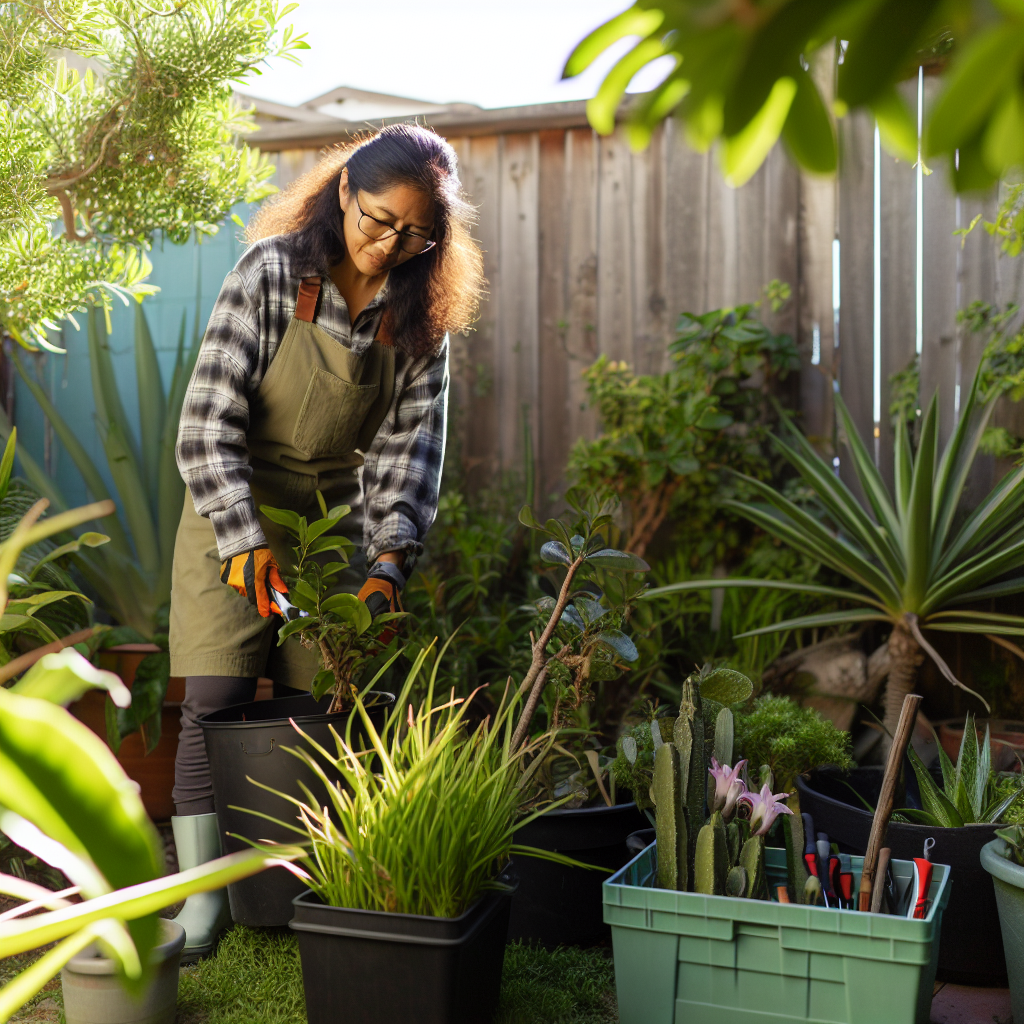
Choosing the Right Plants for Each Season: A Container Gardener’s Guide
Understanding Seasonal Conditions
Each season brings unique weather conditions.
These conditions affect plant growth and health.
Understanding your zone is crucial for success.
Research the plants that thrive in your climate.
Spring Plant Selection
Spring heralds fresh growth and vibrant colors.
Choose cool-season vegetables like lettuce and peas.
Additionally, consider flowering annuals such as pansies.
These plants flourish in the crisp spring air.
Ensure proper drainage to prevent waterlogging.
Summer Plant Selection
Summer heat creates ideal conditions for warm-season crops.
Tomatoes and peppers thrive under full sun exposure.
Add herbs like basil and thyme for culinary delights.
Water regularly to keep your plants hydrated.
Mulch to retain moisture and suppress weeds.
Autumn Plant Selection
Autumn signals a shift toward cooler temperatures.
Consider planting kale and Brussels sprouts for fall harvests.
Pansies can add color, providing beauty during chilly spells.
Use frost blankets to protect delicate plants.
Transitioning pots indoors may be necessary for tender species.
Showcase Your Farming Business
Publish your professional farming services profile on our blog for a one-time fee of $200 and reach a dedicated audience of farmers and agribusiness owners.
Publish Your ProfileWinter Plant Selection
Winter gardening can be rewarding with the right choices.
Opt for evergreen plants, which offer year-round interest.
Consider ornamental cabbage and kale for seasonal color.
If your climate permits, grow winter vegetables like carrots.
Protect containers from freezing temperatures and strong winds.
General Tips for Container Gardens
Always choose plants suited to your specific containers.
Factor in the size and depth of each pot.
Ensure adequate sunlight per your plant’s needs.
Group similarly cared-for plants together for ease of maintenance.
Regularly check for pests and diseases to maintain health.
You Might Also Like: Pest Control Strategies For Urban Gardens
Common Pests and Diseases in Container Gardens
Overview of Common Pests
Container gardens attract various pests throughout the growing season.
Aphids are one of the most common pests affecting container plants.
Spider mites are also frequent pests, especially in dry conditions.
Additionally, whiteflies can become a nuisance during warm weather.
Fungal gnats often thrive in wet, compacted soil in containers.
Japanese beetles can cause significant leaf damage to many plants.
Overview of Common Diseases
Container gardens can suffer from several diseases, including root rot.
Powdery mildew often appears on leaves in humid conditions.
Leaf spot fungus can create unsightly blemishes on foliage.
Botrytis blight typically affects dying plant material and flowers.
Rust is another disease that can flare up during warmer weather.
Seasonal Prevention Strategies
Prevention is crucial for managing pests and diseases in container gardens.
Regularly inspect plants for early signs of pests or disease.
Rotate plants each season to disrupt pest life cycles.
Maintain healthy soil by adding organic matter regularly.
Ensure proper drainage to prevent waterlogged conditions.
Use companion planting to repel pests naturally.
Treatment Options
When pests appear, quick action can minimize damage.
Handpicking pests, like beetles and caterpillars, is effective.
Insecticidal soap can help control soft-bodied insects.
Neem oil is an organic option effective against various pests.
For fungal diseases, applying a fungicide can provide relief.
Ensure proper air circulation around plants to reduce disease risks.
Remove any diseased plant material immediately to limit spread.
Seasonal Timing for Treatment
Spring is a critical time to start pest prevention measures.
Monitor regularly during the summer when pests are most active.
In the fall, prepare plants for winter to reduce disease risk.
Cleaning containers and tools will help reduce pests next season.
Understanding seasonal trends can guide your prevention strategies.
Showcase Your Farming Business
Publish your professional farming services profile on our blog for a one-time fee of $200 and reach a dedicated audience of farmers and agribusiness owners.
Publish Your ProfileSeasonal Decor: Integrating Seasonal Themes into Your Container Gardens
Spring Awakening
Spring is the perfect time to refresh your container gardens.
Incorporate vibrant colors with blooming flowers.
Pansies, tulips, and daffodils work beautifully together.
Add decorative stones or whimsical figurines for extra charm.
Summer Vibrance
Summer containers thrive with bright, tropical colors.
Consider using geraniums, petunias, and marigolds.
Mix in herbs like basil or mint for added fragrance.
Utilize hanging baskets to create vertical interest.
Autumn Warmth
As fall approaches, embrace warm, earthy tones.
Chrysanthemums and ornamental peppers add rich color.
Include pumpkins or gourds for a festive touch.
Swap out summer plants for hardy perennials if needed.
Winter Wonderland
Winter container gardens need less maintenance, yet can still shine.
Evergreens like pine or juniper offer year-round interest.
Integrate festive decor such as lanterns or twinkling lights.
Consider winter-blooming plants like hellebores for color.
Creating a Cohesive Look
Choose a color palette that complements your home’s exterior.
Maintain consistency in container styles for a unified visual theme.
Incorporate seasonal accessories, such as wreaths or themed ornaments.
Location Matters
Position your containers to enhance visibility and impact.
Group them together for a more dramatic effect.
Ensure they receive appropriate sunlight based on plant needs.
Change their location seasonally for variety and freshness.
Additional Resources
What are some possible Cash Crops available to the small farmer …

